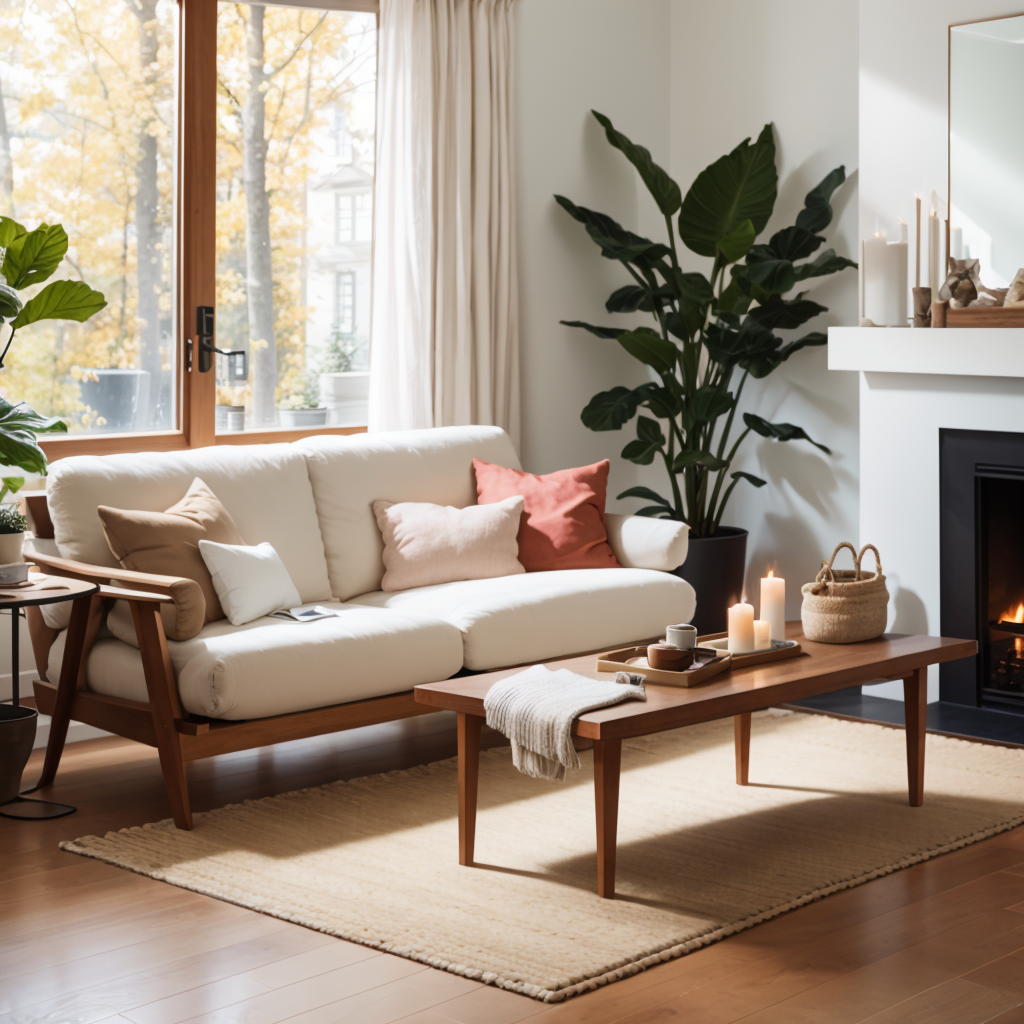
Mid-Century Modern Interior Design Styles: Your Ultimate Guide
Table of Contents

What is Mid-Century Modern Interior Design.
Mid-Century Modern is a design style that originated in the mid-20th century, from the 1930s to the 1960s. It’s often characterized by clean lines, organic curves, and natural materials such as wood and leather.
The design style emerged from a combination of factors, including technological developments such as industrialization and the post-war economic boom. Designers sought to create functional yet beautiful furniture and home decor that would appeal to a growing middle class.
Famous designers who contributed to this movement include Charles and Ray Eames, George Nelson, Isamu Noguchi, Herman Miller, Knoll Associates among many others. The Mid-Century Modern era was known for its experimental approach to design, which has made it popular even today due to its iconic styles that have stood the test of time.
Principles.

- Form follows function: This principle says that an object’s design and form should follow its intended function or purpose. This means that each element in a mid-century modern interior is chosen both for its visual appeal and for the way it functions within the space.
- Clean lines: Mid-century modern interiors are known for their clean, simple lines that create a sense of orderliness and minimalism. Furniture pieces often feature straight edges, crisp angles, and geometric shapes.
- Organic shapes: Despite the emphasis on clean lines, mid-century modern design also features organic, curvilinear shapes in furniture and decor accents such as lamps or art pieces.
- Natural materials: Materials like wood (usually lighter woods such as teak), leather or natural fabrics were popular choices for mid-century modern interiors because they added warmth and texture to space while complementing the sleekness of furniture designs.
- Bold colours: Bold accent colours are synonymous with mid-century modern design elements such as artwork or cushions featuring mustard yellows, oranges or teal paired with muted earth tones to create contrast.
- Mixing old with new-age functionality: Unlike other retro-themed styles where designers recreate outdated look-and-feel without taking into account practicality; Mid-Century Modern Interior Design provides a perfect blend between timeless elegance from earlier decades which are then infused with contemporary functions to meet today’s lifestyle needs.
- Open floor plans: The openness concept is reflected broadly across all aspects; be it large windows bringing maximum light flow into your home allowing nature inside adding another dimension to living spaces while avoiding cluttered walls giving rooms an appearance of spaciousness
By following these principles in your interior decor selections consistently throughout your home’s theme, you can achieve an authentic Mid-Century Modern Interior Design style that emanates sophistication yet simplicity necessary for any modern home.
Colour Palette.
The colour palette used in Mid-Century Modern Interior Design style is a combination of both warm and cool tones. The use of earthy colours such as brown, beige, olive green, and mustard yellow is commonly incorporated with brighter hues like orange, teal, and reds that add a pop of colour to space.

Here are some more details about the colour palette used in Mid-Century Modern Interior Design style:
- Neutral colours: Mid-century modern interiors often employ neutral colours like whites and grays as the base colour for walls. These neutral tones create a clean backdrop for furniture, decor accents, while allowing bolder colours to stand out.
- Earthy tones: Natural earth element-inspired hues such as burnt oranges or olive greens were popular choices during this era, adding warmth to spaces while breaking up monotony
- Bold colours: Bright pops of primary or complementary colours added contrast against the otherwise muted colour scheme creating drama in space often seen in artwork or cushions featuring mustard yellows, oranges, or teal paired with muted earth tones to create contrast.
- Metallic accents: Metal finishes like gold/brass or chrome are popularly added into lighting installations, giving spaces an upscale feel
- Natural wood tones: Light woods (usually teak) were prominent during mid-century modern design; using them adds texture & personality detailing that brings warmth into your home interior design.
By combining all these features together within your home’s decor theme consistently throughout different rooms, you can achieve an authentic mid-century modern style that reflects sophistication while remaining warm & inviting at the same time
Furnitures & Decors.
Here is a guide to furniture and decor in Mid-Century Modern Interior Design style, along with some explanations:
- Furniture: The furniture in this style is characterized by clean lines, simplicity, functionality, inspired by modern European designs. Classic pieces include low-profile sofas and chairs with minimalistic design elements; the legs are often straight or tapered, with a touch of natural wood for warmth.
- Accent chairs: Mid-century modern accent chairs have a unique look that often features bold geometric shapes alongside having organic curves. These chairs are usually upholstered in fabrics like tweed or leather that add texture into space.
- Storage solutions: Functionality is key during Mid-century modern design era –hidden storage solutions from unique cabinets to sideboards/mid-century credenzas were essential additions to create a clutter-free environment.
- Lighting & Artwork: Alongside having functional lighting fixtures, mid-century modern interiors feature graphic prints which served as statement pieces when hung on walls or atop credenzas busts or sculptures were also popular art forms chosen for their interesting shapes.
- Decorative Accessories & Textiles: Plush rugs and textured cushions added warmth, while decorative accessories like vases (often ceramic) ashtrays and candlesticks brought in personality detailing into spaces.
- Plants: Plants played an essential role within mid-century interior design, using them as decorative accents throughout living rooms or bedrooms.
- Mirrors: Mirrors play an important role within mid-century modern homes they’re used frequently as wall decor but also installed above consoles perfect for adding depth, visually enlarging small spaces.
By keeping these characteristics consistent throughout your home’s décor theme, you’ll achieve authentic mid-century-modern-inspired settings that exude elegant simplicity while remaining warm yet inviting at the same time
Materials & Finishes.
Here is a guide to materials and finishes in Mid-Century Modern Interior Design style, along with some explanations:
- Natural Wood: The use of natural woods such as teak, walnut or oak is a defining characteristic of mid-century modern design aesthetic. Wooden elements within furniture pieces showcase the natural grain and texture of the wood itself –examples include side tables, dining tables or chairs.
- Metals: Shiny metals like brass, chrome or gold accents were popularly used in lighting fixtures or decorative accessories that add sophistication & glamour while breaking up monotony.
- Leather: Leather upholstery was commonly added to accent chairs sofas adding texture into living rooms spaces also utilized for storage cabinets/credenzas creating an overall cohesive look within the home’s décor theme
- Upholstery Fabrics:Fabrics used in mid-century modern decor tend to be utilitarian features textured tweeds with neutral tones such as beige grey & browns–refreshed pops of color could be added with orange, green, yellow cushions/throws.
- Stone: mid-century modern designers loved stone -marble tabletops/coffee tables are often seen contributing towards adding elegance and sophistication into any room it graces.
- Glass: Mid-Century Modern era designs frequently incorporated glass surfaces onto their furniture pieces –e.g., coffee tables showcases its elegant simplicity that creates space illusion reflecting light around your home’s interior lending towards overall warmth offered by warm hues from other finishes/textures
- Plastic: Quality- Plastic materials chosen during this time had a clear purpose for functionality without sacrificing aesthetics e.g., plastic molded chairs they’ve recently made comeback as contemporary designs have sought after these iconic classics once more!
By making sure to incorporate some if not all these materials into your spaces you can easily adopt an authentic mid-century-modern-inspired aesthetic that combines organic warmth with sleek industrial touches giving your space personality whilst retaining its timeless appeal!
Room-by-Room design guide.
Here is a room-by-room design style guide in Mid-Century Modern Interior Design style, along with some explanations:
- Living Room: In the living room, mid-century modern design emphasizes comfort with functionality. A low-profile sofa or armchair with clean lines and minimalistic accents makes for an ideal seating option. The use of natural wood for coffee tables, side tables and entertainment units adds warmth to the space, while plush rugs and colourful cushions in textured fabrics such as tweed or leather give a soft touch to the look.
- Dining Room: The dining table is typically the centrepiece of any dining room in mid-century modern design. A rectangular wooden table paired with straight-lined high-backed chairs upholstered in tweed fabric make for an elegant statement piece that screams sophistication.
- Bedroom: For a bedroom that incorporates this design aesthetic, invest in furniture pieces like wardrobes or dressers featuring organic shapes and natural wood finishes; functional lighting solutions such as bedside lamps add practicality to your space, whilst delicate patterns on bedspreads provide subtle touches without overtaking your style.
- Bathroom: Bathrooms can also benefit from incorporating this décor theme -consider installing hexagonal tiles on bathroom walls/floors paired with sleek fixtures (e.g., mirror frameless shower door handles) adding visual interest without sacrificing its overall minimalist appeal.
- Kitchen: Mid-century modern kitchens should focus on storage solutions while keeping it streamlined e.g, Built-in wall cabinets/storage units are ideal for hiding away items leaving countertops clutter-free but also – create a cozy breakfast nook perfect for morning rituals! Keep colours schemes neutral, like pastel blues/greens & warm yellows.
- Home Office/Library: Incorporating wall-to-wall bookshelves made from teak wood/pine helps create a distinguished focal point within home office spaces, adding personality/texture into areas designated strictly work-oriented tasks!
By keeping these elements consistent throughout each room in your home, you’ll create a cohesive mid-century-modern-inspired aesthetic that combines organic warmth with sleek industrial touches and lasting style.




